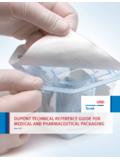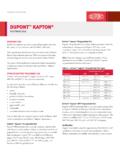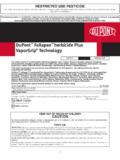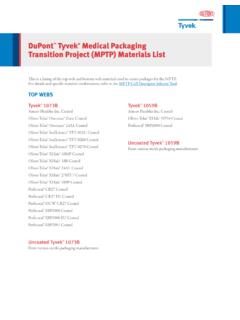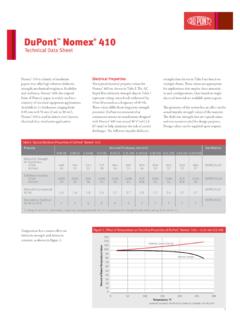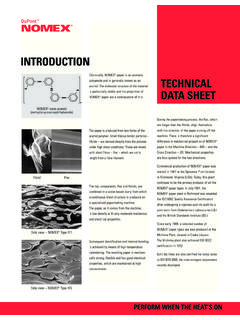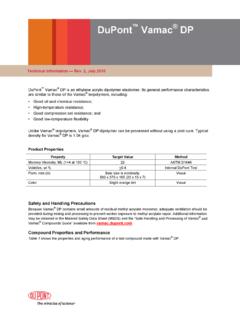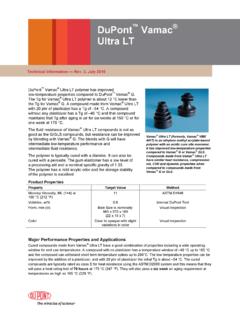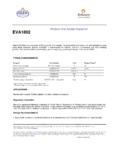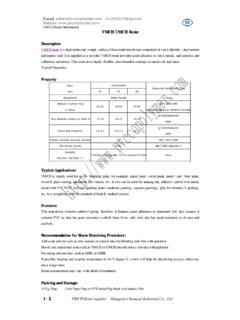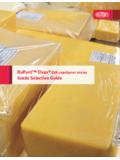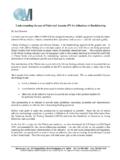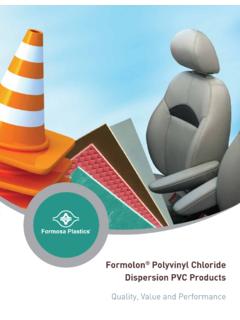Transcription of Elvax and Wax: A Good Fit - DuPont
1 Guide to using DuPont Elvax in wax blends Elvax and Wax: a good fit Overview Background DuPont Elvax ethylene vinyl acetate (EVA) and wax Elvax is a copolymer of ethylene and vinyl acetate. The complement each other in a variety of uses including two key parameters that determine their properties are hot-melt adhesives and curtain coatings for paper. Each weight percent vinyl acetate in the copolymer and melt component has a certain set of properties that makes index (MI). Elvax is made in basically the same process the blend perform well. The wax is relatively low-priced used to make low-density polyethylene (LDPE), and and has low viscosity, good barrier properties to water many of the properties of Elvax can be understood by vapor, and very fast set time.
2 DuPont Elvax has high comparing Elvax to LDPE. As more vinyl acetate is added cohesive strength and good adhesion to paper, and allows to the polymer, it disrupts the polyethylene crystallinity, the wax to maintain its water barrier properties in creases which in turn lowers the melting point, modulus, and and folds. In most cases, both wax and Elvax meet FDA hardness. The VA makes the polymer more polar, which packaging guidelines for direct food contact. improves adhesion to polar substrates and aids in solubility. Of the three major hydrocarbon waxes, paraffin wax is most often used with Elvax . Paraffin wax is Melt index is a measure of how many grams similar in chemical composition to polyethylene (PE), but of polymer flow through a narrow orifice held at 190 C.
3 Has surprisingly poor compatibility with PE. Elvax resins (374 F) for ten minutes. MI is an indication of viscosity and with 18 to 28 percent vinyl acetate (VA) have the best molecular weight (MW). If the MI is low, the viscosity and compatibility with paraffin wax. MW are high. If the MI is high, the viscosity and MW are low. Applications The largest commercial use for an EVA/wax blend is in Types of Waxes hot-melt adhesives, where Elvax and wax make up about The waxes most often used with Elvax are the low-MW. two-thirds of the formulated adhesive. Hot-melts are used hydrocarbon resins listed below: for closing cases and cartons or for binding paperback Paraffin wax books and magazines. Microcrystalline wax Wax and Elvax are also used in food packaging applications as curtain coatings for corrugated paper Synthetic wax boxes.
4 The EVA/wax blend waterproofs the coated paper The paraffin and microcrystalline waxes are present in so that it can be used to ship vegetables or poultry from crude oil and are separated from the crude in a refinery. the farm to the market. There are many other smaller end-uses for EVA/wax blends, ranging from slow-burning candles to glue sticks used by hobbyists and do-it- yourselfers. Elvax and Wax a good fit The paraffin leaves the refinery with lube oil and is separated in a The compatibility of Elvax with the wax seems to be related to lube oil plant. The paraffin is a straight chain hydrocarbon having the freezing points of Elvax . Figure 2 shows the freezing point a melt point (MP) of about 49 to 71 C (120 to 160 F).
5 The and cloud point versus percent VA. We measured the melting microcrystalline wax is separated from the asphalts and is higher and freezing points by differential scanning calorimeter (DSC). in molecular weight and more branched than the paraffin. It has Low-density polyethylene melts at 110 C (230 F), and freezes at a higher MP (60 to 89 C [150 to 190 F]), which gives it better about 89 C (192 F). Its cloud point in paraffin wax is about 90 C. heat resistance than the paraffin. (194 F). The cloud point measurement is actually the temperature at which the LDPE crystallizes. It crystallizes before the wax Synthetic waxes are either low MW polyethylenes or does; then, at a lower temperature, the wax freezes around polymethylenes.
6 The polymethylenes are produced from syngas the polyethylene. The polyethylene acts as a filler and does not plants using the Fischer-Tropsch process. Synthetic waxes melt improve the properties of the wax. at relatively high temperatures, and provide good heat resistance and fast set times. They are significantly higher in price than petroleum waxes. Compatibility of Elvax and Paraffins -- 18 Percent and Lower VA. Why is polyethylene incompatible with paraffin wax when Elvax . is compatible? Polyethylene is a straight chain hydrocarbon resin with a chemical composition almost exactly the same as that of paraffin. Elvax is a copolymer of ethylene and vinyl acetate, and the VA makes the EVA polymer more polar than wax.
7 Figure 1 shows a graph of cloud point in a 66 C. Figure 2. Cloud and Freeze Points in 150 MP. (150 F) melt point paraffin wax versus percent VA in an Elvax . Paraffin Wax (66 C). copolymer . This graph shows why Elvax resins are used in wax blends. To measure cloud point, a blend of 10 percent polymer in wax is heated until the blend becomes clear; then it is allowed Elvax 460, an 18 percent VA copolymer , melts at 87 C (189 F), to cool. The cloud point is the temperature at which the solution and freezes at 66 C (150 F). The freezing point of the polymer starts to cloud up, usually by forming white droplets. Figure 1 ranges from 40 to 80 C (104 to 176 F), with most of the shows that Elvax resins with 18 to 28 percent VA have the best freezing occurring at 66 C (150 F).
8 The polymer freezes at the compatibility with paraffin wax. same temperature as wax. This co-crystallization process allows the EVA resin to reinforce the wax. Elvax with 28 Percent and Higher VA. At vinyl acetate levels greater than 28 percent, the relationship between the EVA and wax changes. To study this, we used a model from polymer-polymer blend theory. Figure 3 shows a typical phase diagram for a two-component mixture. At low levels of each component, the two polymers are compatible, but in the midpoint region they are incompatible. Blends in the midpoint region will become compatible if the temperature is raised to the critical temperature (Tc). We chose the cloud point as a measure of compatibility.
9 Typically, the cloud Figure 1. Cloud Point for Elvax Polymers point is measured at 10 percent polymer in wax, but we chose in a 150 MP Paraffin Wax (66 C) to vary the polymer content from 1 to 30 percent. Figure 3. Generalized Phase Diagram for Two-Component Blend Figure 5. Haze Point of Elvax in Paraffin Wax Figure 4 shows the cloud point for a 28 percent VA copolymer ( Elvax 240) as the percent polymer in the wax is changed. For a Figure 6 is the same as Figure 5 except that the VA level is 28 percent VA copolymer , the cloud point does not change very now up to 33 percent VA ( Elvax 150). The compatibility is much as the polymer concentration is changed. worse at the higher VA levels. As the vinyl acetate content is raised above 28.
10 Percent, the polymer starts to become incompatible with paraffin wax. The worst incompatibility occurs when the polymer concentration is about 5 to 10 percent. A 33. percent VA resin is compatible with wax under conditions where the concentration of Elvax is greater than 30. percent. A 40 percent VA resin is also compatible with wax, but the conditions are more restricted. Figure 4. Haze Point of Elvax in Paraffin Wax Figure 5 shows the cloud point for an experimental 30 percent VA copolymer as the percent polymer in the wax is changed. The maximum incompatibility is seen at 10 percent polymer. For this work, we used the term haze point. Typically, the cloud point is measured at the bottom of a test tube and is seen when the first white droplet is formed.
